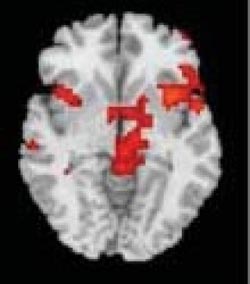Brain hubs boil when hoarders face pitching their own stuff

The anterior cingulate cortex (center) was over-activated when hoarding disorder patients had to decide whether to keep or discard their own possessions; it under-activated during decision-making about others' possessions. The left and right insula (upper left and right) similarly differentially activated in hoarding disorder patients during this task. This picture shows fMRI data superimposed on structural MRI scan.<br><br>Credit: David Tolin, Ph.D., Hartford Hospital<br>
In patients with hoarding disorder, parts of a decision-making brain circuit under-activated when dealing with others' possessions, but over-activated when deciding whether to keep or discard their own things, a National Institute of Mental Health (NIMH)-funded study has found. NIMH is part of the National Institutes of Health.
Brain scans revealed the abnormal activation in areas of the anterior cingulate cortex and insula known to process error monitoring, weighing the value of things, assessing risks, unpleasant feelings, and emotional decisions.
NIMH grantee David Tolin, Ph.D., of Hartford Hospital, Hartford, Conn., and colleagues, report on their functional magnetic resonance imaging (fMRI) study in the August 2012 issue of the journal Archives of General Psychiatry.
Hoarding disorder, a proposed category in psychiatry's new diagnostic manual, DSM-5, is characterized by avoidance of decision-making about possessions.
The new findings pinpoint brain circuit activity suspected of underlying the lack of self-insight, indecisiveness, sense that the wrong decision is being made, inflated estimates of the desirability of objects, and exaggerated perception of risk that are often experienced with the disorder.
In the study, brain activity of 43 hoarding disorder patients was compared to that of 31 obsessive compulsive disorder (OCD) patients and 33 healthy controls while they had to decide whether to keep or discard their own or others' junk mail and newspapers. Notably, such ownership did not appear to differentially affect brain activity in the OCD patients. Hoarding disorder patients, as expected, decided to keep many more items than the other groups.
“The results of this study reflect an accelerating trend toward finding disturbed regulation of brain systems responsible for various dimensions of behavior that may cut across mental disorders as traditionally defined,” said Bruce Cuthbert, Ph.D., director of NIMH's Division of Adult Translational Research.
In this case, the implicated brain areas are hubs of a salience network that weighs the emotional significance of things and regulates emotional responses and states. Hoarding patients' severity of symptoms, self-ratings of indecisiveness, and feeling of things being “not just right” were correlated with the degree of aberrant activity in these hubs. The results add to evidence of impaired decision-making in hoarding disorder and may help to disentangle its brain workings from those of OCD and depression.
Reference:
Neural mechanisms of decision making in hoarding disorder. Tolin DF, Stevens MC, Villavicencio AL, Norberg MM, Calhoun VD, Frost RO, Steketee G, Rauch SL, Pearlson GD. Arch Gen Psychiatry. 2012 Aug 1;69(8):832-41. PMID: 22868937
The mission of the NIMH is to transform the understanding and treatment of mental illnesses through basic and clinical research, paving the way for prevention, recovery and cure. For more information, visit the NIMH website.
About the National Institutes of Health (NIH): NIH, the nation's medical research agency, includes 27 Institutes and Centers and is a component of the U.S. Department of Health and Human Services. NIH is the primary federal agency conducting and supporting basic, clinical, and translational medical research, and is investigating the causes, treatments, and cures for both common and rare diseases.
Media Contact
More Information:
http://www.nih.govAll latest news from the category: Life Sciences and Chemistry
Articles and reports from the Life Sciences and chemistry area deal with applied and basic research into modern biology, chemistry and human medicine.
Valuable information can be found on a range of life sciences fields including bacteriology, biochemistry, bionics, bioinformatics, biophysics, biotechnology, genetics, geobotany, human biology, marine biology, microbiology, molecular biology, cellular biology, zoology, bioinorganic chemistry, microchemistry and environmental chemistry.
Newest articles

Silicon Carbide Innovation Alliance to drive industrial-scale semiconductor work
Known for its ability to withstand extreme environments and high voltages, silicon carbide (SiC) is a semiconducting material made up of silicon and carbon atoms arranged into crystals that is…

New SPECT/CT technique shows impressive biomarker identification
…offers increased access for prostate cancer patients. A novel SPECT/CT acquisition method can accurately detect radiopharmaceutical biodistribution in a convenient manner for prostate cancer patients, opening the door for more…

How 3D printers can give robots a soft touch
Soft skin coverings and touch sensors have emerged as a promising feature for robots that are both safer and more intuitive for human interaction, but they are expensive and difficult…





















